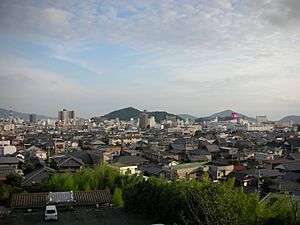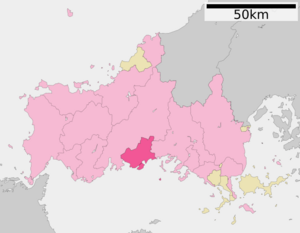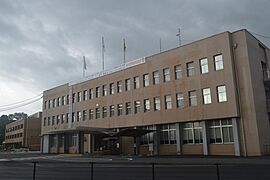Hōfu facts for kids
Quick facts for kids
Hōfu
防府市
|
|||||||||||
|---|---|---|---|---|---|---|---|---|---|---|---|

Hofu city seen from Hōfu Tenman-gū shrine.
|
|||||||||||
|
|||||||||||
 |
|||||||||||
| Country | Japan | ||||||||||
| Region | Chūgoku (San'yō) | ||||||||||
| Prefecture | Yamaguchi | ||||||||||
| Area | |||||||||||
| • Total | 189.37 km2 (73.12 sq mi) | ||||||||||
| Population
(May 31, 2023)
|
|||||||||||
| • Total | 114,846 | ||||||||||
| • Density | 606.464/km2 (1,570.73/sq mi) | ||||||||||
| Time zone | UTC+09:00 (JST) | ||||||||||
| City hall address | 7-1, Kotobukichō, Hōfu-shi, Yamaguchi-ken 747-8501 | ||||||||||
| Climate | Cfa | ||||||||||
|
|||||||||||
Hōfu (防府市, Hōfu-shi) is a city located in Yamaguchi Prefecture, Japan. The name "Hōfu" (防府) actually means "the capital of Suō Province." This tells us a lot about its history!
As of May 2023, about 114,846 people live in Hōfu. It's a city with a good number of people living close together, covering an area of about 189 square kilometers.
Contents
Discovering Hōfu's Location
Hōfu is right in the middle of Yamaguchi Prefecture. It sits by the beautiful Seto Inland Sea to the south. A major river, the Saba River, flows through the city and into the sea.
Long ago, some areas by the sea were used for salt fields. Now, these areas have been reclaimed, creating flat land. Hōfu also includes five islands in the Seto Inland Sea: Sabajima, Mukaishima, Nojima, Hirashima, and Okishima.
Cities Nearby
Hōfu shares its borders with two other cities in Yamaguchi Prefecture:
- Shūnan
- Yamaguchi
Hōfu's Climate
Hōfu has a humid subtropical climate. This means it has hot summers and cool winters. It rains quite a bit throughout the year, but especially in the summer months.
The average temperature in Hōfu is about 15.9 degrees Celsius. July is usually the wettest month. The warmest month is August, with temperatures around 27.5 degrees Celsius. January is the coldest, averaging about 5.0 degrees Celsius.
Hōfu's Population Over Time
The population of Hōfu has changed over many years. Based on Japanese census data, in 2020, about 113,979 people lived in the city. Hōfu has been keeping track of its population since 1920.
A Glimpse into Hōfu's History
The area where Hōfu is located was once part of an ancient region called Suō Province. That's why the city's name, "Hōfu," means "the capital of Suō Province." People have lived here since the Jōmon period, which was a very long time ago!
During the Nara period, an important temple called Suō Kokubun-ji was built in Hōfu. Later, in the Edo Period, this area was part of the Chōshū Domain.
Hōfu officially became a city on August 25, 1936. You can even see how the city changed over 50 years in the animated film Mai Mai Miracle. The story in the film takes place in 1955, with flashbacks going back 1,000 years!
Hōfu's Economy and Industries
Hōfu has always been an important port city. In ancient times, it was well-known for making salt. In more recent times, the area grew quickly with many factories. Textile mills and large factories were built on the old salt farms and along the coast.
Today, Hōfu has many industries related to transportation. A big Mazda automobile factory is located here. Other major companies like Bridgestone, Kyowa Hakko Bio, and Tokai Carbon also have facilities in the city. Hōfu is also home to a training base for the Japan Air Self-Defense Force.
Learning in Hōfu: Education
Hōfu has many schools for its young people. The city government runs 17 public elementary schools and 10 public junior high schools. The Yamaguchi Prefectural Board of Education operates three public high schools.
There are also private schools, including one junior high school and two high schools. For higher education, the private Yamaguchi Junior College is located in Hōfu.
Getting Around Hōfu: Transportation
Trains
![]() JR West operates the San'yō Main Line through Hōfu.
JR West operates the San'yō Main Line through Hōfu.
- Tonomi - Hōfu Freight Terminal - Hōfu - Daidō
Highways
Major roads connect Hōfu to other parts of Japan:
 San'yō Expressway
San'yō Expressway National Route 2
National Route 2 National Route 262
National Route 262
Hōfu's Sister Cities
Hōfu has special friendships with other cities around the world. These are called sister cities:
 Akitakata, Hiroshima, Japan (since July 16, 1971)
Akitakata, Hiroshima, Japan (since July 16, 1971) Chuncheon, Gangwon-do, South Korea (since October 29, 1991)
Chuncheon, Gangwon-do, South Korea (since October 29, 1991) Monroe, Michigan, United States (since May 29, 1993)
Monroe, Michigan, United States (since May 29, 1993)
Fun Places to Visit in Hōfu
Hōfu has many interesting places to explore:
- Hōfu Tenman-gū: A famous shrine.
- Mōri Museum: A museum with historical collections.
- Suō Kokubun-ji: An ancient temple that is a National Historic Site.
- Tamanooya Shrine: An important shrine for the old Suō Province.
Sports and Entertainment
- Hofu Keirin venue: A place where bicycle races (Keirin) are held.
Famous People from Hōfu
Some notable individuals who come from Hōfu include:
- Gin Maeda, an actor
- Kamiyama Mitsunoshin, who was the 11th Governor-General of Taiwan
- Taneda Santōka, a well-known poet
- Hiroki Yasumoto, a voice actor
See also
 In Spanish: Hōfu para niños
In Spanish: Hōfu para niños






